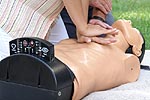| Home A B C D E F G H I J K L M N O P Q R S T U V W X Y Z |
|
Home |
First Aid for Resuscitation
Check to see if the airway is open, if the casualty is breathing, and if the casualty has a pulse. See First Aid: ABC of Resuscitation. No breathing and no pulse: Give the casualty two breaths. Do this by placing the casualty flat on his back. Open the airway by lifting the chin and tilting the head. With the hand that's on the casualty's forehead, use the index finger and thumb to pinch the casualty's nose closed. Cover the casualty's mouth with yours; make a seal over his mouth with yours. Blow air slowly into the casualty's mouth until the chest starts to rise. This should take about two seconds. Be careful not to do this faster because the air will push into the casualty's stomach, causing him to vomit. Remove your mouth from the casualty's. After two breaths, you will have to start compressions. Kneel beside the casualty, preferably on the casualty's right side. The casualty must be on his back on a flat firm surface. If this is not possible, you will have to do compressions in the position that the casualty is in. 1.) Use the ring and middle finger of your left hand to find the casualty's lowest rib. Now slide your fingers up to where the ribs meet the chest bone. 2.) Place your ring finger in this notch and your middle and index finger right next to it. 3.) Now place the heel of your right hand next to the index finger of your left hand. 4.) Place your left hand over your right hand and interlock your fingers. 5.) Lift your fingers so that only the heel of your right hand remains on the casualty's chest. 6.) Kneel up on your full height and lean over the casualty with your arms perfectly straight. 7.) Press down about 4-5 cm. Release the pressure without lifting your hands. 8.) Repeat this 30 times at a rate of approximately one per second. After 30 compressions, check for breathing and a carotid (neck) pulse. If necessary repeat the above cycle of two breaths, followed by 30 compressions. If the casualty doesn't respond to CPR, do not stop unless you are in danger or if the emergency services arrive. No breathing, but there is a pulse: Give artificial breathing, as described above. After every 10 breaths, check for a pulse in the neck and see whether the casualty is breathing spontaneously. If the casualty doesn't respond, repeat the cycle until help arrives. |
||
|
|
||
|
Glossary References Links Contact
|